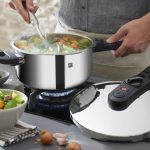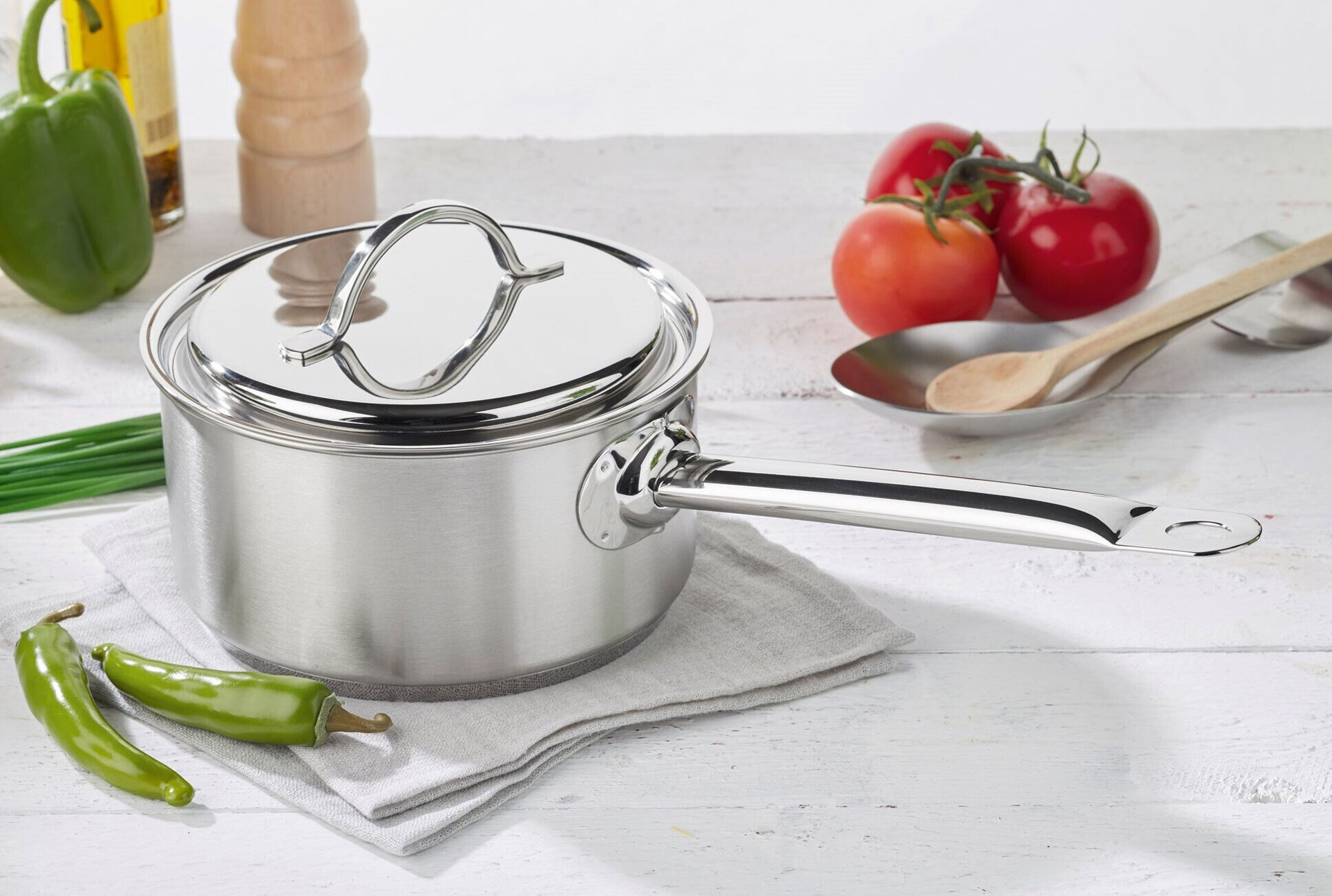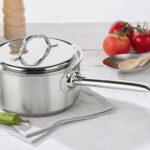
The Benefits of Using Quality Pressure Cookers
One kitchen appliance that has revolutionised the way we prepare meals is the pressure cooker.

The arrival of a new set of stainless steel cookware is a joyful occasion. The second you lay eyes on it—all shiny and pristine—you’re already dreaming of all the searing, caramelizing, and sautéing you’ll be doing. But in the same breath, you also think: Man, I really hope I don’t ruin this gleaming piece of perfection. Because as much as stainless steel pots and pans conduct, distribute, and maintain heat beautifully, and are an absolute joy to have around the kitchen, they also need your care and attention.
Let’s face it: bits of food will stick on, water spots will (too reliably) appear, and dings will happen. Luckily though, there are handy solutions for all this regular wear and tear. Protect your precious pots and pans from discoloration, damage, and debauchery by following these guidelines for cleaning and for caring.
The trick to prevent those rather annoying water spots is to actually get to drying as soon as possible, aka, immediately. If you don’t get to it soon enough, and the spots appear, simply dampen the surface of the pot or pan, rub it with a moist sponge that’s been sprinkled with baking soda, and rinse as usual.
Only salt water once it has already come to a boil. When water is salted pre-boil, “pitting corrosion” can occur, which leaves tiny but irreparable pockmarks, as if from a nail, in the bottom of the pot. So salt your pasta water, yes, but only once it’s boiling.
Always heat your pan before adding on the oil. And then, add the food once the oil is hot. According to Food Network, adding oil to the pan when it’s hot causes the steel to become “static,” which creates a temporarily nonstick surface. Always watch the oil to figure out if it’s hot enough to start cooking: If it’s shimmering, you’re ready to toss in your ingredients.
Take the chill off of cold foods. Cold food is more likely to stick to a hot pan, as the steel will contract when it comes in contact with a cooler temperature. So, if you’re cooking foods like meat, chicken, or fish straight from the refrigerator, allow them to sit at room temperature for 10 to 15 minutes. Before cooking, make sure to dab with a cloth or paper towel to remove excess moisture.
To determine whether your pan is hot enough for the oil, do this simple water test: Drop a tiny amount (about 1/8 teaspoon) water in the pan. When the water, immediately upon hitting the pan, comes together into a “ball” that glides and dances across the surface, your pan is preheated perfectly—now, you can add the oil! Note that this is past the point at which the water sizzles when it hits the pan’s surface: When the pan is properly hot, the water shouldn’t “sit” on the surface at all.
Do not rush the preheating process by using high heat. Since high-quality stainless steel is effective at holding heat, preheating on high might lead to overheating your pan (and burning your food).
Allow the pan to cool completely before washing it. Submerging or soaking a hot stainless steel pan in cold water could be the cause of irreparable warping.
Only use non-abrasive cleaners and sponges. Coarse scrubbers and harsh cleaning solutions like bleach or household cleaners can scratch your stainless steel and damage its finish. And although baking soda and more abrasive scrubbers (like fine steel wool) can be useful in cleaning a burnished pan, beware that using these products might void your warranty.
Stick to a routine. Clean your stainless steel pans and pots after each use (even if it doesn’t get very dirty), to avoid a buildup.
For cleaning chalky white spots (which can result from calcium buildup in the water): Bring a solution of vinegar and water (think 1:3) to a boil in the pan, let it cool, and then wash and dry as normal.
For general buildup: Fill the pan with hot soapy water, and let sit a few hours, before scrubbing with a non-abrasive sponge.
For stuck-on food bits (which can result from adding cold food to a hot pan—see above!): Scrub the pot with a non-abrasive sponge to get off any food bits you can, then fill the pot or pan with enough soapy water to cover the food, bring to a boil, and scrape (the food should come away easily). You can also do this by replacing soap with a couple spoons of baking soda. Bring it to boil (but watch closely, as it will bubble up), and then reduce it to a simmer. Using a wooden spoon, scrape off the bits of food, which should come off pretty easily. Once you’re pleased with the results, turn it off and let it cool (but don’t let it get totally cold). Take it to the sink and use a long-handled brush or scouring pad to scrub off your mess (but don’t forget to dry immediately!).
For discolouration (often rainbow in appearance), which can occur from overheating: fret not, for a solution is well in sight. Here’s what you do: Splash a little white vinegar diluted with water into your pan, swirl the mixture around, and use a non-abrasive sponge to wipe away the rainbow stains. Vinegar’s acidity will help break down that thin oxidized rainbow layer while still being gentle on your pans. (Alternatively, a sprinkle of Barkeeper’s Friend, which is similarly acidic yet non-corrosive, will also do the trick.) Rinse, dry, and…voila! Your stainless steel will be gleaming good as new.
For hard-to-clean burnt or burnished pans:
– If you have Barkeeper’s Friend: Pour a small amount of water in the pan or pot, add a few shakes of B.K.F., and create a paste or slurry by mixing the two together. Scrub with a non-abrasive sponge to remove the stains.- If you don’t have Barkeeper’s Friend: Fill the bottom of the pan with water, then add 1 cup of vinegar and bring to a boil. Remove from the heat and add 2 tablespoons of baking soda (beware that this might void your warranty!). Empty the pan and scrub (some people even recommend using 0000 very fine steel wool, which should not scratch). For stubborn spots that still won’t budge, you can make a paste of baking soda and water and leave it applied to the problem areas for a few minutes and then scrub and rinse off.
Cookware Obsession is an Austrian online retailer of quality cookware, and resellers of Demeyere and other leading brands. We are highly passionate about the brands and products we sell, and we are avid hobbyists in the culinary arts.

One kitchen appliance that has revolutionised the way we prepare meals is the pressure cooker.

Chicken Tikka is made by marinating tender pieces of chicken in a flavorful blend of spices and yogurt, and then grilling or baking until cooked to perfection.

Spaghetti Carbonara is a classic Italian pasta dish originating from the Lazio region, specifically Rome.

While a skilled chef can create magic in the kitchen with even the most basic equipment, investing in high-quality cookware can elevate your culinary experience to new heights.

The arrival of a new set of stainless steel cookware is a joyful occasion. The second you lay eyes on it—all shiny and pristine—you’re already dreaming of all the searing, caramelizing, and sautéing you’ll be doing.
Monday to Friday: 09h00 – 17h00
Please email us for international order enquiries.